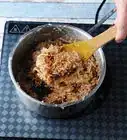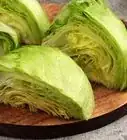This article was co-authored by wikiHow Staff. Our trained team of editors and researchers validate articles for accuracy and comprehensiveness. wikiHow's Content Management Team carefully monitors the work from our editorial staff to ensure that each article is backed by trusted research and meets our high quality standards.
There are 9 references cited in this article, which can be found at the bottom of the page.
The wikiHow Video Team also followed the article's instructions and verified that they work.
This article has been viewed 144,891 times.
Learn more...
Grated coconut is an ingredient that's used in popular desserts like cakes, pies, and macaroons. You can purchase dried grated coconut from the store, but if you want freshly grated coconut, it's just a matter of getting a coconut and following some simple techniques. To grate coconut, you need to crack it open first, then use a box grater or a food processor to grate it. Finally, you can dry your coconut flakes out using an oven or dehydrator to achieve the same texture as the grated coconut from the store.
Steps
Purchasing and Opening the Coconut
-
1Buy a coconut that's free of cracks and damage. Before you purchase your coconut, examine the surface of it to make sure that there are no cracks or mold on it. Healthy coconuts will be heavy because they are filled with liquid. Shake the coconut to see if you can feel the liquid inside.[1]
- Coconut water helps keep the white flesh of the coconut from drying out.
-
2Puncture the eye of the coconut. The eye of the coconut will look like a dark circle. Often there is tree eyes in the coconut. Find the softest one and press against it with a sharp object like a knife, screwdriver, or wine opener. Your tool should easily puncture through the hard shell and into the flesh of the coconut.Advertisement
-
3Drain the water from the fruit. Once you've punctured past the hard shell, turn the coconut over and drain the water out of it into a bowl. If you want, you can drink the drained coconut water.
-
4Crack open the coconut with the back of a heavy knife. Rotate the coconut in your hand and rap against the side of it with the back of a heavy kitchen knife. Make sure that the blade isn't facing the coconut. As you rotate it, you should hear and see it crack open.[2]
-
5Throw the coconut against a hard surface to crack it open. Place the coconut inside of a plastic bag and throw it hard against the concrete floor or a brick wall. This will shatter the coconut apart and make it easier to get at the white flesh of the fruit.[3]
Shredding the Coconut with a Food Processor
-
1Pry the white meat from the brown skin. Use a flathead screwdriver or a spoon to pry the white meat of the coconut from the surrounding skin. If your coconut is in pieces, you can just pare off the skin using a sharp knife.[4]
-
2Cut the coconut flesh into smaller pieces. If your coconut flesh came off in big chunks, it might not fit in your food processor. Cut the pieces of coconut into smaller squares so that it can fit in your food processor.
-
3Pulse the coconut in the food processor. Take the white pieces of coconut that you cut off and put them into your food processor and pulse it for 10-15 seconds.[5]
-
4Stop the food processor and scrape off the edges. Open the top of the processor and scrape the coconut that got stuck to the sides of the processor.[6]
-
5Grind the coconut again. Continue processing the coconut until it reaches the consistency that you want. Once you're done grinding it up, you can put the flakes in the refrigerator or dehydrate them.[7]
- Fresh coconut flakes will stay good in the refrigerator for two to three days.
Grating Coconut with a Box Grater
-
1Remove the white coconut flesh from the skin. Pry the coconut from the skin by shoving a flathead screwdriver in between the white flesh and the brown skin. Bigger pieces are easier to grate when you are using a box grater, so try to remove large pieces.[8]
-
2Hold the grater by the handle. Using your non-dominant hand, grab onto the top handle of the box grater and hold it tightly. As you grate, use your arm to keep the grater pressed tightly against the cutting board or table.[9]
-
3Hold the coconut against the holes and move it back and forth. Choose how small you want your coconut flakes. Use the large holes on the grater if you want to have larger coconut flakes and the medium or small holes for smaller flakes. Grab the white coconut flesh with your dominant hand and move it back and forth against the holes of the grater.[10]
Drying the Coconut
-
1Pour the coconut flakes onto an oven sheet or tray. Take your shredded coconut and spread it evenly onto a cooking sheet. Use a paper towel to pat down the flakes and remove as much moisture as you can before you dehydrate them.
-
2Put the coconut in a convection oven for two hours. Place the cooking sheet inside of a convection oven at 100 - 125°F (40 - 50°C) for two hours. This will draw the moisture out of the coconut and dry out the flakes.[11]
-
3Dehydrate the flakes for six hours at 130°F (54.4°C) . If you have a dehydrator, you can use it to dry out your coconut instead of the oven. Place the flakes inside of the dehydrator and allow them to dry out for eight to ten hours, or long enough until they are dried to your liking.[12]
- Dehydrated coconut flakes will last 2-3 months in a zip lock bag.[13]
Community Q&A
-
QuestionHow much grated coconut is there in a typical coconut?
 MicheleTop AnswererOne large coconut will yield approximately 1 pound of meat, or about 5 to 6 cups grated.
MicheleTop AnswererOne large coconut will yield approximately 1 pound of meat, or about 5 to 6 cups grated. -
QuestionWhat's the advantage of grating coconut like this rather than just grating raw coconut using an electronic or hand grater?
 MicheleTop AnswererThe article does show the use of a hand grater, but an electric grater or food processor would work as well.
MicheleTop AnswererThe article does show the use of a hand grater, but an electric grater or food processor would work as well. -
QuestionHow long will grated coconut last before it becomes rancid?
 MicheleTop AnswererIt can keep in the fridge for a few weeks, longer if lightly coated with powdered (confectioner's) sugar. It can keep for months in the freezer. To coat with sugar, place the hardened flakes in a strainer (sieve) and lightly dust with sugar, shaking off excess over a paper plate. The sugar helps to keep the flakes dry, and thus less likely to go rancid too soon. You could also toast them, then refrigerate.
MicheleTop AnswererIt can keep in the fridge for a few weeks, longer if lightly coated with powdered (confectioner's) sugar. It can keep for months in the freezer. To coat with sugar, place the hardened flakes in a strainer (sieve) and lightly dust with sugar, shaking off excess over a paper plate. The sugar helps to keep the flakes dry, and thus less likely to go rancid too soon. You could also toast them, then refrigerate.
Things You'll Need
- Coconut
- Knife
- Screwdriver
- Plastic bag
- Cooking sheet
- Food processor or box grater
- Oven or dehydrator
References
- ↑ http://www.epicurious.com/recipes/food/views/to-crack-and-grate-fresh-coconut-101279
- ↑ http://www.davidlebovitz.com/how-to-prepare-fresh-coconut/
- ↑ http://www.foodnetwork.com/recipes/coconuts-opening-grating-and-liquado-recipe-1970788
- ↑ http://www.davidlebovitz.com/how-to-prepare-fresh-coconut/
- ↑ http://www.foodnetwork.com/recipes/coconuts-opening-grating-and-liquado-recipe-1970788
- ↑ http://thenaughtyvegan.com/how-to-shred-coconut.htm
- ↑ http://www.paleoplan.com/ingredients/is-canned-grated-coconut-paleo/
- ↑ http://www.davidlebovitz.com/how-to-prepare-fresh-coconut/
- ↑ https://www.saltedtv.com/skills/how-to-use-a-grater-by-chef-gianfranco-minuz
About This Article
To grate coconut, start by separating the flesh from the skin with a knife or screwdriver. If the flesh comes off in large chunks, chop them up into smaller pieces before pulsing them in a food processor. Stop the processor and scrape off the coconut stuck to the edges, then grate it again. To use a box grater instead, hold the grater by the handle and move the coconut flesh backwards and forwards on the grater. Finally, dry out the coconut by placing the flakes in a convection oven at 120 degrees F for 2 hours. For tips on how to buy a coconut and how to crack it open, read on!



















































